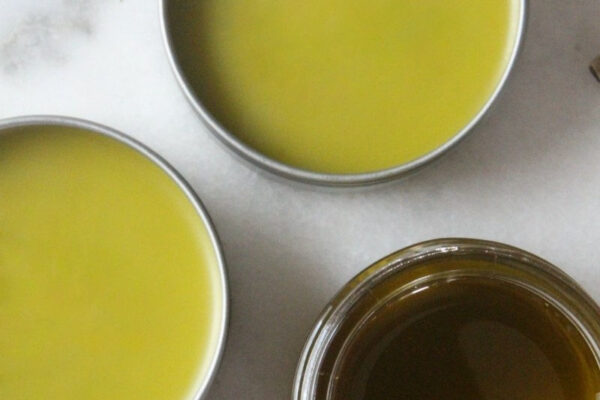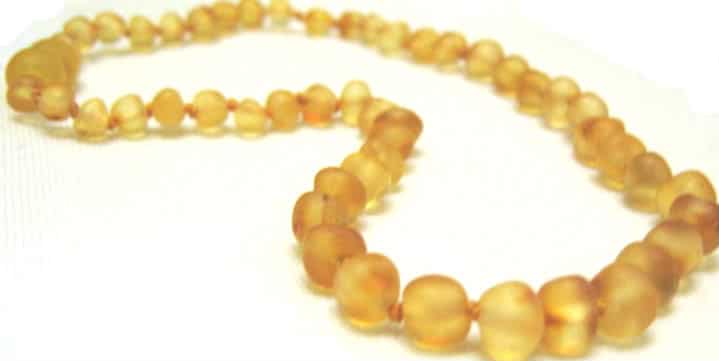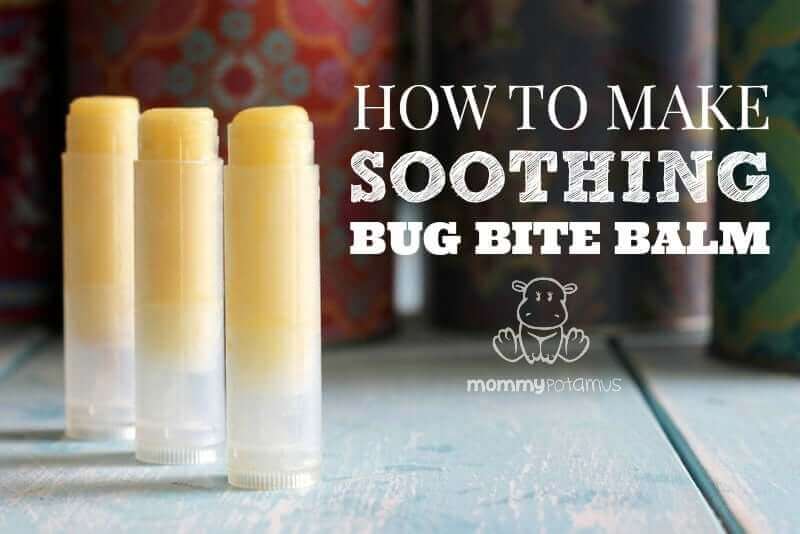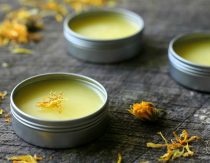
Sometimes called knitbone or All Heal, comfrey (Symphytum officinale L.) has been used for centuries to support wound and bone healing, and at one time was recommended as a tea to soothe digestive issues. Most often found in moist grasslands, this perennial herb is rich in a bioactive compound called allantoin that plays a role in cell formation and granulation.
In other words, it supports the body in creating new tissue and microscopic blood vessels during the healing process.
It’s often used for:
- Soothing sprains, bruises, swelling, minor shallow-cut skin injuries and burns
- Easing tight muscles
- Boosting softness and shine when used as a hair rinse
- Moisturizing skin, which is why it’s incorporated into many skin serums, creams and salves
In this article I’ll show you how to infuse the therapeutic properties of comfrey into oil, make it into an herbal salve, and we’ll also dive into the controversy around comfrey tea.
As always, I want to mention that none of these statements have been evaluated by the FDA, this article is not medical advice, and it is not meant to diagnose or treat any condition. Please talk with your healthcare provider about any herbal supplements you are considering.
How To Use Comfrey Externally ^
Although ingesting comfrey is not recommended (more on that below), using comfrey externally is considered safe and can be very helpful for supporting the healing process with breaks, sprains, and strains, as well as minor shallow-cut skin injuries and burns. (1) It’s even been shown to ease tight muscles and support a healthy inflammatory process. (2)(3) Comfrey roots are the most powerful, followed by young leaves, with older leaves considered the least powerful.
Of course, you don’t just rub roots or leaves on whatever area you’re trying to address. Most often, the therapeutic compounds in comfrey are infused into a carrier oil and then massaged onto the area. Other times, a plaster of fresh leaves or poultice made from dried leaves is applied.
We’ll dive into how to make comfrey oil, comfrey salve and a comfrey plaster/poultice below, but first here are some safety considerations you should know about external use:
- Some people experience a skin rash reaction from comfrey leaves, so be careful during your first time handling them or using remedies made with comfrey leaves.
- As we’ll dive more deeply into below, comfrey contains several compounds called pyrrolizidine alkaloids, or PAs, which can cause liver damage if taken internally. Chemically speaking PAs have very low solubility in oils, so comfrey oils and salves should be low in PAs. (4) However, my coauthor for this article, registered herbalist Lori Rose, PhD, RH (AHG), and professor at Hill College’s Holistic Wellness Pathway, recommends using it for no more than 4-6 weeks at a time to avoid any potential toxicity issues.

Comfrey Oil: How To Make It & Where To Buy It ^
The most common way of using comfrey externally for connective tissue injuries or small wound healing is through comfrey-infused oils. Below is my super easy and affordable process for making it, but if you don’t want to DIY you can find comfrey oil here. Because the bottles only contain one ounce you’d need four to make the salve recipe below.
Another option would be to just buy two and cut my recipe in half, or buy some comfrey roots/leaves and make it at home for much less. Here’s what you’ll need:
Ingredients
- Organic dried comfrey leaves or comfrey roots
- Olive oil (Or another oil that you prefer. Almond and avocado oil are good options, as is jojoba)
Instructions (Slow Method)
This is the traditionally preferred method because it’s thought to preserve the delicate constituents found in comfrey (and other herbs) best. However, sometimes it’s just not practical to wait 4-6 weeks for a batch, so I’ve also included a faster method below.
- Place dried comfrey leaf or root in a clean, dry glass jar.
- Next, pour in the oil – add enough so that the comfrey is covered by about one-half inch of oil. Herbs expand as they soak in liquid, so adding the half inch ensures that they stay covered. Comfrey root will stay at the bottom so it’s easy to tell how much to add, but comfrey leaves float and that can make things a bit more challenging. What I do is use my thumb to mark the top of the dried comfrey in the jar before I add the oil, then add about 1/2 inch above that.
- Cover the jar with a tight fitting lid and give it a good shake.
- Place the jar in a paper bag and store near a warm, sunny window. Some people skip the paper bag, but others believe it helps protect some of the valuable constituents found in comfrey from breaking down due to UV light. Give the jar a good shake when you walk by it every day.
- Once the oil has been infusing for 4-6 weeks, strain out the herbs and pour the oil in a clean, glass jar. Store in a cool, dark cabinet until needed.
Slow Cooker Instructions (Quick Method)
- Follow steps 1-3 from the “Slow Method” section above.
- Cover your jar with cheesecloth (or a paper towel that is cut into a small square) and secure it with a rubber band.
- Place a kitchen towel in the bottom of your slow cooker and place your jar inside. Add enough water to cover about half the jar and set to the lowest setting for 2-24 hours. My slow cooker has a warm setting so I can infuse it at a very low temperature for 24 hours, but for slow cookers that only have a “low” setting instead of a “warm” setting, I recommend only infusing for 2-8 hours. Whether or not you place the lid on the slow cooker is largely determined by how hot it gets and how long you plan to infuse it. If you’re infusing it on low for 2-3 hours the lid will probably be helpful in helping it warm up more quickly and retain heat better, but if you’re infusing for 3-6 hours the lid may cause too much heat to be retained. You can always start with the lid and remove it if you decide to extend the infusing time. If your slow cooker tends to run hot I recommend leaving the lid off.
- Strain out the comfrey leaves/roots using cheesecloth and pour the herbal oil in a clean, glass jar. Store in a cool, dark cabinet until needed.
How To Make Comfrey Salve ^
Equipment
- double boiler or stainless steel bowl and a pot
- 2 ounce tins or small glass jar
Ingredients
- 4 oz. comfrey infused oil (make your own using the recipe above or buy it here)
- ½ oz. beeswax (by weight, or about 2 tablespoons beeswax pastilles)
- 25-50 drops essential oil (optional – frankincense, Roman chamomile, tea tree, and lavender essential oil are good choices)
- ½ tsp vitamin E oil (optional)
Instructions
- Gently heat the beeswax in a double boiler. If you don’t have a double boiler you can use a stainless steel bowl set inside a pot of boiling water.
- When the beeswax is melted, add in the comfrey oil and vitamin E oil (if using). Allow it to warm up for 30-60 seconds, then stir until the beeswax and oil are thoroughly mixed. If you’re adding essential oils, wait until the mixture has cooled just a little and then stir them in.
- Pour your salve into a clean, dry container and allow it to cool – I used three of these 2 ounce tins. Now you’re ready for the next bug attack, bee sting, scrape, etc.
Notes
How to make comfrey poultice ^
If you want to avoid the time and effort involved in making oils and salves, a comfrey poultice can be placed directly on unbroken or unabraded skin.
Here’s a super simple method for making a poultice: Place your dried or fresh herbs in a white cotton sock or muslin bag (or make a bag with cheesecloth), then tie a knot the top. Place the bag in a bowl of hot water and use a large spoon to “knead” it for a minute or so to get the herbs to begin releasing their therapeutic compounds.
Remove the poultice from the water, check the temperature to ensure that it’s warm but not so hot that it will irritate skin, then apply it to the affected area.
Is comfrey tea safe? ^
The short answer: The Botanical Safety Handbook, 2nd Edition, lists comfrey as Class 2a, 2b, and 2c: which means that it is recommended for external use only, and not for use in pregnancy or nursing. Comfrey is not recommended for use with deep wounds or unset bones.
The long answer: Although it’s been traditionally used both externally and internally, recent documentation of serious liver damage from drinking comfrey tea has prompted many herbalists to stop recommending the internal use of comfrey. External use of comfrey is still considered safe, though, so comfrey shouldn’t be thrown out of your herbal toolkit altogether.
The problem with comfrey is that every plant contains varying levels of several kinds of pyrrolizidine alkaloids, or PAs. PAs cause veno-occlusive liver disease in some people, a condition where the breakdown of the PAs release pyrroles that damage the veins in the liver that eventually leads to scarring and clogging (4).
This isn’t based on some petri dish or lab-rat study…these are real people and veno-occlusive liver disease can – and has been – fatal. However, those are individual case reports, and no human clinical trials can be done to test the safety of comfrey due to the potential risks. (5)
Some herbalists argue that the risks have not been properly assessed because there are several kinds of comfrey – common comfrey (S. officianale), prickly comfrey (Symphytum asperum) and Russian comfrey (S. uplandicum) – and it’s unclear which one was consumed in the cases that reported negative effects. Certain cultivars are thought to be lower in PAs than others, but more research is needed to confirm that.
The chances of someone getting liver occlusion from PA ingestion can’t be predicted. Liver occlusion is more likely to occur in people with compromised livers or people with malnourishment, but it can occur in anyone, any age, any time. On the other hand, some people can ingest comfrey and never get an occluded liver.
The entire comfrey family contains PAs, including the common garden companion borage. Roots contain the largest amounts of PAs, and the oldest leaves contain the least. Other medicinal herbs that contain PAs are the lung-remedy coltsfoot immune supporting boneset (Eupatorium perfoliatum). The aster, pea, and orchid families also contain PAs (over 6,000 plants).
This debate is compounded by the fact that not all PAs are dangerous. Of the 650+ PAs currently known, non-toxic PAs are found in Echinacea and other medicinal aster family species. Coltsfoot (an antitussive herb) PAs are rumored to be toxic, but many attribute this to mistaken identification of a known toxic look alike, Petasites, and not coltsfoot.
Coltsfoot PAs are mostly the non-toxic kind, but it does have extremely small amounts of the known hepatotoxic PAs. (4) Some herbalists will use coltsfoot long term; some will use it short term; some won’t use it with pregnant women/children; some won’t use it at all.
Alternatives to comfrey tea for internal use ^
Comfrey was historically recommended internally to support healing when there is a dry cough or connective tissue injury (bone and skin). Fortunately, there are alternative herbs for both of these situations that don’t pose the same risk as comfrey.
Mullein leaf and marshmallow root can be taken together as a moistening, restorative, lung-supportive remedy when a dry cough is present. To make a simple tea, pour 1/2 ounce of each into a jar and steep in 1 quart of lukewarm/cold water for 4-8 hours, then strain and drink.
For bone or other connective tissue injuries, consuming foods that provide nutrients for healing can go a long way. Bone broth, ample protein, healthy fats, foods and herbs high in B-vitamins, vitamin C, vitamin E, bioflavonoids, and minerals can be consumed during an injury, as well as getting adequate sun exposure for Vitamin D along with the benefits of infrared light. Comfrey can be used externally to support healing as well.
More Salve Recipes To Try ^
Calendula Salve – This healing salve is rich in compounds that nourish, hydrate, and support skin healing. I call it my #allthethingsbalm because it can be used as a face moisturizer, chapped lip balm, baby bottom balm, owie salve, burn salve, bug bite balm and more. It’s super easy to make, too!
Plantain Salve – Can you really make a first aid ointment out of a backyard weed and items in your pantry? Yes you can, and chances are your kids will love helping you gather “medicine.” Like many salves, this recipe is good for bee stings, sunburn, poison ivy, eczema flares, diaper rash and more.
Moisturizing Hand Salve – Loads of dishes, gardening, dry weather . . . whatever’s got your hands feeling chapped and dry, this easy hand salve is perfect for dry skin and cuticles. Just melt and pour the ingredients and you’re done!
Want more research-backed natural remedies? ^
No problem, I’ve created a free ebook for you – Kitchen Apothecary: 25+ Natural Remedies Using Ingredients From Your Pantry – as a gift for signing up for my newsletter. You’ll also get updates when I post about safe essential oils for pregnant/breastfeeding mamas, exclusive gifts and coupons (I was able to give away a jar of free coconut oil to anyone who wanted it recently!), plus other goodies.
Sign up using the form below.
Have you used comfrey before? ^
Please tell me about your experience in the comments below!
About the authors: This article was co-authored by Heather Dessinger and Dr. Lori Valentine Rose (PhD). Dr. Rose, PhD is a college biology, nutrition, herbal, and wellness instructor, Certified Nutrition Professional (CNP), Registered Herbalist with the American Herbalist Guild, and is Board Certified in Holistic Nutrition. She created, developed, and instructs the Hill College Holistic Wellness Pathway, the most thorough, affordable, degreed wellness program in the country. She loves spreading love and light, and helping others feel awesome on the inside and out so they can live their dreams and make this world more awesome!
Sources for this article:
1. Barna, M et. al. (2007) Wound healing effects of a Symphytum herb extract cream (Symphytum x uplandicum NYMAN: ): results of a randomized, controlled double-blind study
2. Kucera, M et. al. (2005) Topical symphytum herb concentrate cream against myalgia: a randomized controlled double-blind clinical study
3. Grube, B et. al. (2007) Efficacy of a comfrey root (Symphyti offic. radix) extract ointment in the treatment of patients with painful osteoarthritis of the knee: results of a double-blind, randomised, bicenter, placebo-controlled trial
4. Ganora, Lisa. (2009) Herbal Constituents: Foundations of Phytochemistry
5. Comfrey Central. Case Reports of Toxicity with Internal Use of Comfrey





